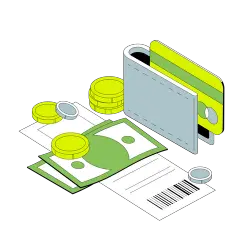PayPal chargebacks can produce many challenges for merchants relying on this platform. While PayPal has an internal transaction dispute process, account holders paying with a credit card can also initiate a chargeback via their credit card issuer if they wish to bypass the PayPal dispute process. And despite the complexity of PayPal’s chargeback process, the platform remains a leader in the payment industry. After all, if your business seeks a well-recognized payment platform with a large built-in user base, it’s hard to imagine a more suitable platform than PayPal.
This comprehensive guide explores how PayPal chargebacks work, how they differ from traditional transaction disputes, and how your business can avoid chargeback-related revenue loss. Let’s dive in!
What Is a PayPal Chargeback?

A PayPal chargeback occurs when a cardholder disputes a payment via their credit card issuer. Payments can be disputed due to stolen credit card details, various forms of fraud, merchant error, or a host of other reasons.
While PayPal has a buyer protection program and internal transaction dispute process, cardholders in the United States also have the right to file chargebacks. Since the passing of the Fair Credit Billing Act in 1974, United States cardholders have had the ability to challenge charges on their credit cards. This amendment lies outside of a payment service provider‘s internal dispute process. Therefore, when a cardholder files a chargeback, PayPal is not the party that resolves the dispute. Instead, PayPal provides the transaction information to the credit card network to help them resolve the dispute. As a merchant, you must work with your customer’s card issuer or network to resolve the chargeback.
How the PayPal Chargeback Process Works
When a cardholder initiates a chargeback, the issuing bank notifies PayPal. Once PayPal receives the notification of a chargeback against your account, they freeze the corresponding funds in your account to ensure funds are available for the customer if their chargeback is successful.
Next, your business must decide whether to approve or contest the chargeback. If you agree the customer has a valid case for a chargeback, accepting it results in a refund issued to the customer and chargeback penalty fees issued to your business.
If you wish to fight the chargeback, you must submit relevant documentation to prove the charge’s legitimacy. The credit card issuer has the right to decide whether your evidence meets the required threshold proving legitimacy. If you don’t agree with the issuer’s decision, your business can proceed to arbitration.
Whether you choose to accept or fight the chargeback, your business must respond within ten days of being notified of the chargeback.
PayPal Chargeback Fees
Merchants utilizing the payment platform are subject to PayPal seller fees on all transactions. Additionally, merchants incur a chargeback fee in the event a customer’s chargeback is successful. You’re not only responsible for returning funds to customers filing successful chargebacks, but you’re also responsible for any additional associated fees.
If a customer files a successful chargeback against your PayPal account, PayPal typically assesses a $20 fee. However, the PayPal Seller Protection Program may help you avoid refunds and chargeback fees!
Why Do Paypal Chargebacks Occur?
PayPal chargebacks most often occur due to fraud, merchant mistakes, and various other reasons:
- True Fraud: True fraud refers to fraud executed by scammers. This may occur if someone hacks a PayPal account or uses stolen credit card details on PayPal.
- Friendly Fraud: Friendly fraud refers to consumers who file a chargeback to recuperate funds, regardless of whether they received the goods or services for which they paid.
- Missold Products or Services: If products or services are sold under misleading product descriptions or are in some way faulty, customers may file chargebacks if you refuse refunds.
- Shipping Issues: If products never arrive, customers may assume your business’s activities are fraudulent and initiate a chargeback.
- Unclear Return Policies: If you don’t clearly state return eligibility and timelines, a customer may use the chargeback process to return items or seek refunds.
PayPal Dispute vs. Claim vs. Chargeback
Customers using credit cards to purchase goods via PayPal have three options for resolving issues: disputes, claims, and chargebacks.[1]PayPal. “Disputes, claims, chargebacks, and bank reversals“. Accessed on November 29, 2022. Each of these processes works differently. We explore them in more detail below:
Dispute
A “dispute” refers to an internal PayPal dispute process in which the credit card issuer is not involved. If a customer has an issue with a product or service sold via PayPal, they can raise an internal dispute. The merchant has 20 days to resolve the issue or process a refund.
Claim
If a customer is not satisfied with a resolution from a dispute, they can raise the issue to a PayPal claim. This process involves PayPal, which assesses the transaction details and decides whether to initiate a payment reversal. Merchants have ten days to respond to PayPal claims.
Chargeback
A PayPal chargeback occurs when a cardholder contacts their credit card issuer to dispute a charge. PayPal is notified of the chargeback by the issuer and asks the merchant if they want to dispute the chargeback. The transaction funds are frozen until the issuer makes its final chargeback decision.
How to Fight a PayPal Chargeback
Fighting a PayPal chargeback may help your business avoid chargeback fees and unnecessary refunds. However, fees aren’t the only downside of chargebacks—every successful chargeback brought against your business raises its chargeback ratio. Businesses with high chargebacks can be subject to higher payment processing fees or PayPal account termination, completely eliminating the business’s ability to utilize one of today’s most popular payment platforms.
Because disputing a chargeback requires time and money, it’s not recommended you fight every chargeback, but it’s often worth it if you have evidence to prove the transaction was legitimate.

1. Submit relevant documentation
Retaining data regarding payments, products, and customers remains essential in the fight against chargebacks. Submit the following information to PayPal to prove the transaction’s legitimacy:
- Shipping tracking numbers
- Proof of delivery
- Product description(s)
- Your business’s return policy
- Server information regarding digital products
- Communication with the customer (emails, support chats, etc.)
- Any additional transaction data

2. Communicate with the PayPal chargeback team
While credit card issuers are ultimately responsible for the final decision regarding a chargeback, PayPal has an in-house chargeback team for its merchants. This team communicates information regarding the status of your dispute and supports you through the process.

3. Wait for their decision
It can take up to 75 days for a chargeback decision to be rendered, though most chargebacks are resolved within a shorter time period. A successful chargeback results in a refund to the customer and a chargeback fee. However, if the chargeback decision is in your favor, PayPal will unfreeze your funds and settle the matter.
If you lose a chargeback dispute but believe the issuer came to an incorrect decision, you can initiate an arbitration process. At this point, the credit card network—Visa, Mastercard, American Express, or Discover—issues the chargeback decision.
How to Prevent Chargebacks on PayPal in 8 Easy Steps
Reducing chargebacks on PayPal should be a top priority for any business wanting to retain revenue and maintain its payment processing. Fortunately, incorporating a few internal practices will help your business avoid the costs associated with chargebacks:
- Provide Accurate Product Descriptions: Misleading product descriptions leave your business exposed to chargebacks. Card issuers evaluate your product descriptions to determine if the cardholder’s dispute is accurate.
- Employ Shipping Tracking: Delivery tracking helps confirm if a customer received physical goods.
- Ensure Your Business’s Trading Name Is on Its PayPal Account: Customers may not recognize a charge and initiate a chargeback if you don’t use your trading name on your PayPal account.
- Utilize Authorization Holds: Using authorization holds prevents chargebacks because you can reverse a payment upon a customer’s request.
- Make It Easy to Contact Your Business: Clearly list your business’s support options so customers can go directly to you rather than PayPal or their issuing bank.
- Clearly Outline Return Policies: A clear and fair return policy prevents angry or confused consumers from initiating a chargeback.
- Retain Relevant Transaction Documentation: Whether it’s retaining server information for digital products or shipping information for physical products, all evidence may prove worthwhile.
- Engage with PayPal’s Seller Protection Program: The PayPal Seller Protection Program provides additional tools for combatting chargebacks and related costs.
The PayPal Seller Protection Program

The PayPal Seller Protection Program absorbs some of the costs associated with chargebacks if the merchant adheres to its strict guidelines for selling goods and services.[2]PayPal. “What is the PayPal Seller Protection Policy and what items aren’t covered?“. Accessed on November 29, 2022. PayPal for Business accounts offer Seller Protection at no additional charge for eligible transactions. There is no restriction on the number of payments eligible for coverage as long as merchants fulfill the eligibility criteria.
Physical products must ship to the correct address with proof of shipment, delivery, and delivery confirmation. (For digital goods, the threshold of proof is much higher.) Additionally, goods and services must be accurately described. Lastly, you must respond to requests for information and documentation within the timeframes set by PayPal.
While there are many hurdles to jump through to properly follow the rules in the PayPal Seller Protection Program, it does provide your business with additional protection against chargebacks and disputes.
6 Ways to Implement a Fraud Protection Strategy
If you want to implement an effective fraud prevention strategy, it’s best to be as comprehensive as possible. Following some of the below steps will help you avoid fraudulent charges:
- Utilize PayPal’s instant payment notifications to prevent unnoticed fraud.
- Make sure your orders are eligible for PayPal’s Seller Protection Program.
- Always respond to PayPal claims within proper timeframes.
- Include all available documentation in any dispute, claim, or chargeback.
- Stay in constant communication with PayPal’s fraud team to ensure you follow best practices.
- Keep yourself informed of the latest scams impacting merchants.
Fighting and Preventing PayPal Chargebacks: Closing Thoughts
Understanding how PayPal chargebacks differ from refunds, disputes, and claims remains essential for businesses using this payment processing platform. By using the PayPal Seller Protection Program, you’ll unlock additional security when accepting credit cards via PayPal and avoid unnecessary fees! And for even more protection, consider incorporating an effective chargeback prevention management system from a reputable merchant services provider!
FAQs About Paypal Chargebacks & Fraud
How long do you have to respond to PayPal disputes?
With a PayPal chargeback, your business must respond within ten days, the same timeline is valid for a PayPal claim. However, with a PayPal dispute, your business has 20 days to resolve the dispute with the buyer.
How long do customers have to file a chargeback?
The length of time a customer has to file a chargeback varies depending on the credit card issuer. The Fair Credit Billing Act requires at least a 60-day period for filing a chargeback. However, many credit card networks offer much longer periods. For example, cardholders have 120 days to initiate a Mastercard chargeback.
Is there a PayPal chargeback time limit?
PayPal does not set chargeback time limits. Card issuers are responsible for setting chargeback time limits for their cardholders. While US laws dictate this limit must be at least 60 days, many card issuers and card networks offer more time.
How long does it take PayPal to see chargebacks?
The point at which PayPal receives a notification about a chargeback depends on the card issuer. When a customer files a chargeback, the issuer compiles the relevant information and forwards it to PayPal as soon as possible. It may take up to 30 days for PayPal to dispute the chargeback with the card issuer and an additional 75 days for the card issuer to provide a final decision.






